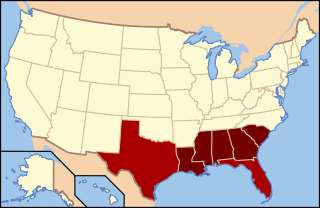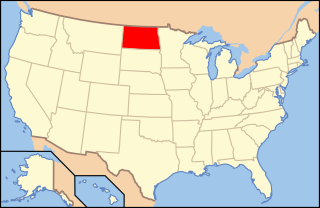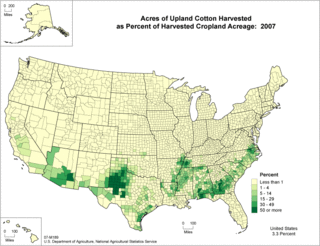
The Agricultural Adjustment Act (AAA) was a United States federal law of the New Deal era designed to boost agricultural prices by reducing surpluses. The government bought livestock for slaughter and paid farmers subsidies not to plant on part of their land. The money for these subsidies was generated through an exclusive tax on companies that processed farm products. The Act created a new agency, the Agricultural Adjustment Administration, also called "AAA" (1933–1942), an agency of the U.S. Department of Agriculture, to oversee the distribution of the subsidies. The Agriculture Marketing Act, which established the Federal Farm Board in 1929, was seen as an important precursor to this act. The AAA, along with other New Deal programs, represented the federal government's first substantial effort to address economic welfare in the United States.

The People's Party, usually known as the Populist Party or simply the Populists, was an agrarian populist political party in the United States in the late 19th century. The Populist Party emerged in the early 1890s as an important force in the Southern and Western United States, but declined rapidly after the 1896 United States presidential election in which most of its natural constituency was absorbed by the Bryan wing of the Democratic Party. A rump faction of the party continued to operate into the first decade of the 20th century, but never matched the popularity of the party in the early 1890s.

The Mount Rushmore National Memorial is a national memorial centered on a colossal sculpture carved into the granite face of Mount Rushmore in the Black Hills near Keystone, South Dakota, United States. The sculptor, Gutzon Borglum, named it the Shrine of Democracy, and oversaw the execution from 1927 to 1941 with the help of his son, Lincoln Borglum. The sculpture features the 60-foot-tall (18 m) heads of four United States presidents: George Washington, Thomas Jefferson, Theodore Roosevelt, and Abraham Lincoln, chosen to represent the nation's birth, growth, development, and preservation. Mount Rushmore attracts more than two million visitors annually to the memorial park which covers 1,278 acres. The mountain's elevation is 5,725 feet (1,745 m) above sea level.

The Deep South or the Lower South is a cultural and geographic subregion of the Southern United States. The term was first used to describe the states which were most economically dependent on plantations and slavery, specifically Louisiana, Mississippi, Alabama, Georgia, and South Carolina. After the American Civil War ended in 1865, the region suffered economic hardship and was a major site of racial tension during and after the Reconstruction era.
The history of Georgia in the United States of America spans pre-Columbian time to the present-day U.S. state of Georgia. The area was inhabited by Native American tribes for thousands of years. A modest Spanish presence was established in the late 16th century, mostly centered on Catholic missions. The Spanish had largely withdrawn from the territory by the early 18th century, although they had settlements in nearby Florida. They had little influence historically in what would become Georgia.

The Farmers' Alliance was an organized agrarian economic movement among American farmers that developed and flourished ca. 1875. The movement included several parallel but independent political organizations — the National Farmers' Alliance and Industrial Union among the white farmers of the South, the National Farmers' Alliance among the white and black farmers of the Midwest and High Plains, where the Granger movement had been strong, and the Colored Farmers' National Alliance and Cooperative Union, consisting of the African American farmers of the South.

The history of agriculture in the United States covers the period from the first English settlers to the present day. In Colonial America, agriculture was the primary livelihood for 90% of the population, and most towns were shipping points for the export of agricultural products. Most farms were geared toward subsistence production for family use. The rapid growth of population and the expansion of the frontier opened up large numbers of new farms, and clearing the land was a major preoccupation of farmers. After 1800, cotton became the chief crop in southern plantations, and the chief American export. After 1840, industrialization and urbanization opened up lucrative domestic markets. The number of farms grew from 1.4 million in 1850, to 4.0 million in 1880, and 6.4 million in 1910; then started to fall, dropping to 5.6 million in 1950 and 2.2 million in 2008.

Peter Norbeck was an American politician from South Dakota. After serving two terms as the ninth Governor of South Dakota, he was elected to three consecutive terms as a United States Senator. Norbeck was the first native-born Governor of South Dakota to serve in office, and the first native-born U.S. Senator from South Dakota. He is best remembered as "Mount Rushmore's great political patron", for promoting the construction of the giant sculpture at Mount Rushmore and securing federal funding for it.

Jonah LeRoy "Doane" Robinson was an American historian who was the state historian of South Dakota. He is known for conceiving of the idea for the Mount Rushmore National Memorial in the Black Hills, which he believed would stimulate tourism to the area.

The Green Corn Rebellion was an armed uprising that took place in rural Oklahoma on August 2 and 3, 1917. The uprising was a reaction by European-Americans, tenant farmers, Seminoles, Muscogee Creeks, and African-Americans to an attempt to enforce the Selective Draft Act of 1917. The name "Green Corn Rebellion" was a reference to the purported plans of the rebels to march across the country and to eat "green corn" on the way for sustenance. They hoped to be joined by thousands of sympathizers, march to Washington, D.C., overthrow the federal government, abolish the draft, and end U.S. involvement in the war. Many of the rebels were aligned with the Socialist Party of America.

George Nelson Peek was an American agricultural economist, business executive, and civil servant. He was the first administrator of the Agricultural Adjustment Administration (AAA) and the first president of the two banks that would become the Export-Import Bank of the United States.

The Socialist Party of Oklahoma was a semi-autonomous affiliate of the Socialist Party of America located in the Southwestern state of Oklahoma. One of the last states admitted to the Union, the area later incorporated into Oklahoma had been previously used for reservations to which indigenous Native American populations were deported, with the area formally divided after 1890 into two entities — an "Oklahoma Territory" in the West and an "Indian Territory" in the East.

The construction of Mount Rushmore National Memorial began on October 4, 1927, and took 14 years to complete. The sculptor of the memorial was Gutzon Borglum, the son of Danish immigrants. He chose the two most famous presidents, George Washington and Abraham Lincoln, and chose Thomas Jefferson because of the 1803 Louisiana Purchase. Theodore Roosevelt was suggested by Calvin Coolidge. Borglum's original design was intended to go down to their waists, but time constraints and funding only provided for their heads.

The Socialist Party of North Dakota was the semi-autonomous affiliate of the Socialist Party of America established in 1902 in the state of North Dakota. The organization had roots in a socialist club founded by Norwegian immigrants in Fargo in 1900. One of the party's professional organizers, a former farmer named Arthur C. Townley, abandoned the group in 1915 to establish a new organization called the Non-Partisan League. The rapid growth of this organization spelled the demise of the official Socialist organization in the state.

The United States exports more cotton than any other country, though it ranks third in total production, behind China and India. Almost all of the cotton fiber growth and production occurs in the Southern United States and the Western United States, dominated by Texas, California, Arizona, Mississippi, Arkansas, and Louisiana. More than 99 percent of the cotton grown in the US is of the Upland variety, with the rest being American Pima. Cotton production is a $21 billion-per-year industry in the United States, employing over 125,000 people in total, as against growth of forty billion pounds a year from 77 million acres of land covering more than eighty countries. The final estimate of U.S. cotton production in 2012 was 17.31 million bales, with the corresponding figures for China and India being 35 million and 26.5 million bales, respectively. Cotton supports the global textile mills market and the global apparel manufacturing market that produces garments for wide use, which were valued at USD 748 billion and 786 billion, respectively, in 2016. Furthermore, cotton supports a USD 3 trillion global fashion industry, which includes clothes with unique designs from reputed brands, with global clothing exports valued at USD 1.3 trillion in 2016.

The following works deal with the cultural, political, economic, military, biographical and geologic history of pre-territorial South Dakota, the southern part of Dakota Territory and the State of South Dakota.

Norbeck-Williamson Act of 1929 or Mount Rushmore National Memorial Act of 1929 established the Mount Rushmore National Memorial Commission defining the powers and purpose of the twelve member committee. The Act of Congress authorized the Mount Harney Memorial Association of South Dakota to stone carve models of George Washington, Thomas Jefferson, Abraham Lincoln, and Theodore Roosevelt in the Harney National Forest encompassed by the Black Hills National Forest. The granite sculpture was to be created in accordance with the rock relief designs by Gutzon Borglum.

The Black Belt in the American South refers to the social history, especially concerning slavery and black workers, of the geological region known as the Black Belt. The geology emphasizes the highly fertile black soil. Historically, the black belt economy was based on cotton plantations – along with some tobacco plantation areas along the Virginia-North Carolina border. The valuable land was largely controlled by rich whites, and worked by very poor, primarily black slaves who in many counties constituted a majority of the population. Generally the term is applied to a larger region than that defined by its geology.

Railroad land grants in the United States made in the 1850s to 1870s, were instrumental in the building the nation's railway network in the Central United States west of Chicago. They enabled the rapid settlement of new farm and ranch lands as well as mining centers. Overall, government land grants to Western US railroads during the 1850s to 1880s played a crucial role in shaping the economic, social, and geographic landscape of the United States, laying the foundation for much of the nation's modern transportation infrastructure and facilitating the westward expansion of settlement and industry.

Cora Babbitt Johnson was an American journalist and preservationist known for her vocal opposition to the Mount Rushmore project in the Black Hills of South Dakota. A Black Hills local herself, she worked as editor-in-chief of the Hot Springs Star newspaper for eight years before becoming a features writer for other publications of the Great Plains. As part of the early conservation movement in the United States, Johnson raised concern over the Mount Rushmore project's potential impact on the local ecosystem, community, and natural beauty of the Black Hills.

















